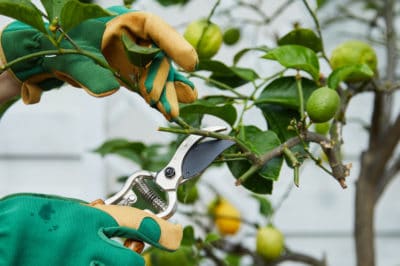When Is the Best Time to Prune a Lemon Tree?
You can trim your lemon tree any time, but scheduling heavy pruning for between February and April. Don’t prune heavily in summer, when your tree may be stressed from heat. Also avoid it in winter, because the nutrients and energy your tree needs to produce its next crops of flowers and fruit are stored in the twigs, leaves and branches.
Expert gardener’s tip: Nearly every variety of lemon tree (Citrus limon) comes equipped with protective thorns on its trunk and branches. Unless you’re fortunate enough to be growing a thornless cultivar, heavy leather gloves – preferably forearm length – are a must when pruning.
Pruning Suckers
As non-bearing rootstock shoots that sprout from the bases of grafted lemon trees, suckers steal water and nutrients. If your tree is growing where freezes are possible in USDA hardiness zones 9 through 11, prune suckers when danger of frost is past. Otherwise, they may regrow and suffer damage that could harm the entire tree.
What Should I Prune?
Besides removing suckers, you should prune:
- Dead, damaged or diseased branches and twigs. On lemon trees, dead wood is usually gray.
- The weaker of crossing branches.
- Branches that block light from the canopy’s interior. Do this only if absolutely necessary, because it exposes inner branches and fruit to sunburn.
Never take more than 20 percent of the branches, and leave the lower ones intact if possible. They shade the thin-skinned trunk from sunburn — and they’re also the easiest ones to harvest!
What Pruning Tools Do I Need?
In addition to hand pruners, you may need branch loppers or a curved tree saw. Always use sharp, clean tools.
How Do I Prune Large Branches?
Prune branches more than 1 1/2 inches in diameter with the curved saw by making a three-part cut starting between 6 inches and 1 foot from the branch collar. That’s the raised area of trunk tissue at the base of the branch. It protects pruning-exposed exposed wood from decay.
Saw one-third of the way through the underside of the branch. Then move three inches further from the collar and cut through the branch until it drops off the tree. Finally, cut the stub back to the collar.
